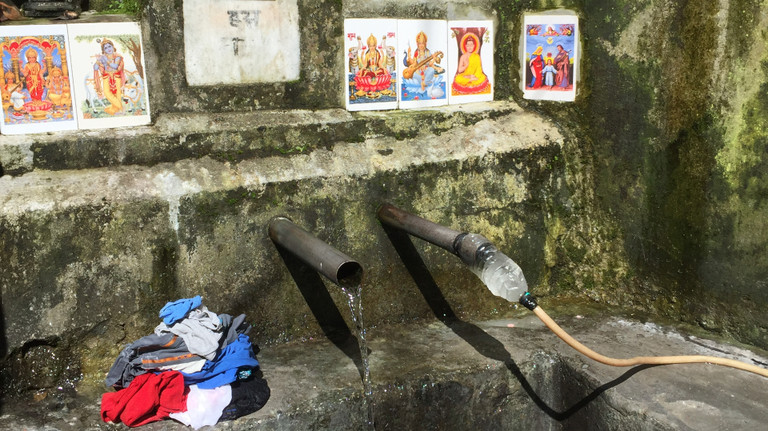Embracing disruptive resilience
Urban areas are increasingly threatened by the impacts of climate change. IIED's Human Settlements research group is exploring new approaches for involving local communities in reducing risk and building resilience.

Public water pipes in Gangtok, India (Photo: David Dodman, IIED)
The risks that cities face are becoming more extreme (with more outlier events), teleconnected (where events in one place lead to disturbances in another) and complex (where multiple hazards unfold simultaneously and often in the same location).
These risks affect the poor and marginalised most. Therefore, existing approaches of reducing risk and building urban resilience need to be replaced with newer ‘disruptive’ methods that are fit for the constantly changing risks that cities face.
We need more effective approaches for engaging communities in decision-making, using new forms of decentralised data, and novel and nimble finance mechanisms that can be deployed swiftly.
The problem
Cities are already suffering the impacts of the climate emergency. These include higher temperatures, more intense rainfall, and coastal and river flooding.
There is also a rise in the occurrence of multiple concurrent hazards that lead to compound and complex crises. For instance, in the first year of the COVID-19 pandemic, 92 extreme weather events had unfolded in locations that were battling the pandemic.
These events disproportionately impacted urban areas, exposing 51.6 million people globally to an overlap of floods, droughts or storms and the pandemic.
Another major evolution in the urban context is the growth of transboundary and teleconnected risk. Growth in the density of global economic, political and social networks (that are concentrated in cities) means that disturbance in one part of the globe can easily lead to disruption in another – often in ways that cannot be accurately predicted.
These evolving risks impact low-income and other vulnerable people most acutely. This is particularly the case for the 30% of the world’s urban population that lives in informal settlements characterised by poor health indicators, lack of access to basic services and deficits in governance. Recent migrants are also highly vulnerable, often because of their exclusion from community-based networks and social services.
These vast, vulnerable and rapidly growing urban populations need support to become resilient to these constantly shifting risks from the climate emergency. But this requires a radical transition to novel ways of understanding climate risk, planning, partnerships and financing.
The solution
We need new ways of generating data, new models of financing, and innovative mechanisms of citizen participation to build disruptive resilience.
However, evidence shows that existing approaches to collecting and analysing data – such as projections from climate models, satellite pictures, census information or participatory approaches – fall far short. They are not dynamic, cost effective or granular enough to understand the extreme, dynamic risk confronting cities today.
Instead, we need to couple these existing approaches with those that capture high-resolution, decentralised local-level data that emanates cheaply, swiftly and regularly from those most at risk, which is essential for dealing with upheaval.
This could entail the use of ‘big data’ – data collected in large volume at high velocity from information and communication devices or insights from bottom-up self-enumeration exercises carried out by those living in informal settlements.
We also need fresh approaches for financing resilience. Existing finance modalities prevent cities from dealing with extreme, concomitant and unpredictable disturbances. For example, international climate finance is too slow and too difficult for cities to access, and rarely reaches the local level.
Likewise, national funds are scarce or earmarked for planned activities and municipal resources are severely strained across the global South. Instead, we need endogenous and nimble sources of finance controlled by cities and their most vulnerable citizens to complement existing streams.
This includes the need to scale up innovative financing modalities such as urban poor funds (local pooled savings) and municipal resilience bonds. These have helped cities raise the resources needed to reduce risk swiftly and at scale in varied contexts, but more needs to be done to enhance their uptake by city governments.
We also need a new approach for engaging urban residents in planning for risk management. A billion urban residents around the world live in informal settlements, accounting for more than 50% of many major urban centres in the global South. But for the most part, they are not treated as genuine partners in governance and planning.
Authorities must shift from encouraging local ‘participation’ in risk management policies and programmes to ensuring citizen ‘partnership’ and enabling local leadership.
Governments must recognise the expertise of residents of informal settlements and use their contextual knowledge as the basis for designing more resilient neighbourhoods by devolving financial and decision-making authority appropriately.
This is also vital because these vulnerable citizens are inevitably the first responders when unanticipated risks or disturbances – which cities are now increasingly facing – overwhelm formal risk management systems.
Building on our work
IIED’s Human Settlements research group has been at the forefront of generating evidence to support resilience in cities. We have worked with researchers and practitioners from dozens of cities around the world to document the nature of climate threats to some of the most vulnerable people, and have published many accounts of these in our Environment and Urbanization journal.
We recognise and champion the value of community-driven data collection, as exemplified by SDI’s Know Your City campaign.
We have also documented and developed alternative mechanisms for managing funds in ways that meets the needs of low-income urban residents. We have shown how community-managed funds are more responsive to local priorities, and can often deliver results at a lower overall cost.
Involving residents of low-income and informal settlements in a meaningful way in decision-making is central to much of our work, whether it is around informal settlement upgrading, water and sanitation, or climate resilience.
The necessary solutions to these problems build on our experiences of including all voices in community planning. For example, we are involved in significant ongoing work in Tanzania where communities are leading the examination of multiple risks in informal settlements in partnership with our researchers.
Taken as a whole, our work shows how the challenges of informality can be acknowledged, and the opportunities of informality grasped, in making more resilient and sustainable cities.
To ensure that this message is mainstreamed, we work with governments and donors. For instance, in a recent extensive, multi-year initiative undertaken with the Asian Development Bank, IIED’s researchers provided technical assistance to governments in South and Southeast Asia to integrate these solutions in national and local policies.
Myth buster: “Urban areas have more resources and are more resilient”
There is a persistent myth that urban areas are better resourced and are therefore inherently more resilient than other contexts. However, historically, non-urban contexts have received much more attention from those financing and delivering programmes to enhance resilience to climate impacts.
This is evident from the fact that only 11% of multilateral climate funds have gone to cities. This is partly because there is an assumption that cities have access to more resources and have greater capacity to respond to risks.
In reality, urban governments across the world lack the capacity to respond to the climate emergency: a survey of 350 municipalities across five continents found:
- 53% did not understand how they could address the issue of climate change
- 51% were unaware of the impacts of climate change and did not comprehend how the issue was relevant locally
- Only 4% had a team dedicated to dealing with urban climate change issues, and
- 78% reported the lack of funding lack for implementing projects and programmes on climate change as a significant challenge.
It is time to dispel the myth that urban areas are inherently resilient and recognise cities as a crucial theatre in the battle against climate impacts.
Contact
Aditya Bahadur (aditya.bahadur@iied.org), principal researcher, IIED's Human Settlements research group



